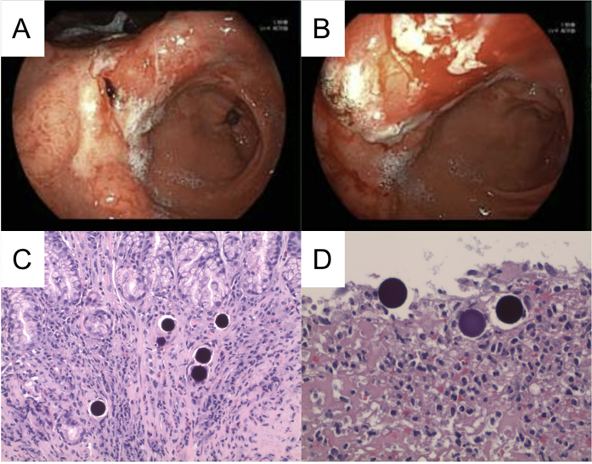Monday Poster Session
Category: GI Bleeding
P3120 - Embedded Yttrium-90 Beads-Related Bleeding Gastric Ulcer: A Rare Cause of Upper Gastrointestinal Bleeding
Monday, October 27, 2025
10:30 AM - 4:00 PM PDT
Location: Exhibit Hall

Harneet Sangha, BS (he/him/his)
Washington State University Elson S. Floyd School of Medicine
Auburn, WA
Presenting Author(s)
Harneet Sangha, BS1, Amanda Doherty, MD2, Mohit Girotra, MD3
1Washington State University Elson S. Floyd School of Medicine, Spokane, WA; 2CellNetix Pathology and Laboratories, Seattle, WA; 3Swedish First Hill Medical, Seattle, WA
Introduction: Intrahepatic tumor radioembolization is a locoregional treatment, by selectively delivering ionizing radiation from yttrium-90 (Y-90) encapsulated microspheres through the hepatic artery, taking advantage of the differential blood supply of tumors and normal liver tissue. Angiographic mapping before the procedure and prophylactic embolization are key to minimizing non-target embolization and resultant gastrointestinal (GI) side effects like mucosal ischemia and ulceration. Incidental deposition of microspheres into adjacent organs occurs despite these precautions. We present the case of Y-90-induced upper GI bleeding (UGIB) in patient with breast cancer metastatic to the liver.
Case Description/
Methods: A 48-year-old woman with a 5-year history of breast cancer, initially treated with surgical excision of high-grade DCIS in 2021, was later found to have residual grade 3 invasive ductal carcinoma. Over time, her disease progressed, and a PET/CT in March 2023 revealed widespread metastases involving the liver, bones, lungs, and multiple lymph node regions. She underwent systemic chemotherapy and subsequent Y-90 radioembolization to the liver in December 2024 and January 2025. Patient now presented with upper abdominal pain, prompting endoscopic evaluation.
EGD findings revealed a single 15 mm non-bleeding superficial ulcer with a clean base (Forrest III) at the incisura, surrounded by severe gastric inflammation. Biopsies were obtained from the ulcerated region (margins and center). Histopathology revealed severe chronic active gastritis with ulceration, fibrinopurulent exudate, and foreign material consistent with Y-90 microspheres. No evidence of Helicobacter pylori, dysplasia, or malignancy was identified. While the findings are non-specific, in the absence of alternative etiologies, the gastric injury is most likely attributable to Y-90 microsphere deposition.
The patient was managed conservatively with escalation of proton pump inhibitor therapy and scheduled for follow-up endoscopy in 3 months to monitor ulcer healing.
Discussion: Y-90 TARE is selective treatment for hepatic tumors, yet GI side effects in the form of ulceration can occur as a result of non-target embolization. This case adds to the 8 other cases reported for Y-90–mediated gastric injury with biopsy-proven microsphere deposition within the gastric mucosa.

Figure: A/B: EGD images with gastric incisura ulcer, and surrounding erythema and heaped up margins, mild oozing is noted after biopsies. C: Gastric mucosa exhibiting both acute and chronic inflammation, with prominent deep-purple spherical structures consistent with Y-90 beads. D: High-power view showing Y-90 microspheres embedded within the ulcer bed.
Disclosures:
Harneet Sangha indicated no relevant financial relationships.
Amanda Doherty indicated no relevant financial relationships.
Mohit Girotra indicated no relevant financial relationships.
Harneet Sangha, BS1, Amanda Doherty, MD2, Mohit Girotra, MD3. P3120 - Embedded Yttrium-90 Beads-Related Bleeding Gastric Ulcer: A Rare Cause of Upper Gastrointestinal Bleeding, ACG 2025 Annual Scientific Meeting Abstracts. Phoenix, AZ: American College of Gastroenterology.
1Washington State University Elson S. Floyd School of Medicine, Spokane, WA; 2CellNetix Pathology and Laboratories, Seattle, WA; 3Swedish First Hill Medical, Seattle, WA
Introduction: Intrahepatic tumor radioembolization is a locoregional treatment, by selectively delivering ionizing radiation from yttrium-90 (Y-90) encapsulated microspheres through the hepatic artery, taking advantage of the differential blood supply of tumors and normal liver tissue. Angiographic mapping before the procedure and prophylactic embolization are key to minimizing non-target embolization and resultant gastrointestinal (GI) side effects like mucosal ischemia and ulceration. Incidental deposition of microspheres into adjacent organs occurs despite these precautions. We present the case of Y-90-induced upper GI bleeding (UGIB) in patient with breast cancer metastatic to the liver.
Case Description/
Methods: A 48-year-old woman with a 5-year history of breast cancer, initially treated with surgical excision of high-grade DCIS in 2021, was later found to have residual grade 3 invasive ductal carcinoma. Over time, her disease progressed, and a PET/CT in March 2023 revealed widespread metastases involving the liver, bones, lungs, and multiple lymph node regions. She underwent systemic chemotherapy and subsequent Y-90 radioembolization to the liver in December 2024 and January 2025. Patient now presented with upper abdominal pain, prompting endoscopic evaluation.
EGD findings revealed a single 15 mm non-bleeding superficial ulcer with a clean base (Forrest III) at the incisura, surrounded by severe gastric inflammation. Biopsies were obtained from the ulcerated region (margins and center). Histopathology revealed severe chronic active gastritis with ulceration, fibrinopurulent exudate, and foreign material consistent with Y-90 microspheres. No evidence of Helicobacter pylori, dysplasia, or malignancy was identified. While the findings are non-specific, in the absence of alternative etiologies, the gastric injury is most likely attributable to Y-90 microsphere deposition.
The patient was managed conservatively with escalation of proton pump inhibitor therapy and scheduled for follow-up endoscopy in 3 months to monitor ulcer healing.
Discussion: Y-90 TARE is selective treatment for hepatic tumors, yet GI side effects in the form of ulceration can occur as a result of non-target embolization. This case adds to the 8 other cases reported for Y-90–mediated gastric injury with biopsy-proven microsphere deposition within the gastric mucosa.

Figure: A/B: EGD images with gastric incisura ulcer, and surrounding erythema and heaped up margins, mild oozing is noted after biopsies. C: Gastric mucosa exhibiting both acute and chronic inflammation, with prominent deep-purple spherical structures consistent with Y-90 beads. D: High-power view showing Y-90 microspheres embedded within the ulcer bed.
Disclosures:
Harneet Sangha indicated no relevant financial relationships.
Amanda Doherty indicated no relevant financial relationships.
Mohit Girotra indicated no relevant financial relationships.
Harneet Sangha, BS1, Amanda Doherty, MD2, Mohit Girotra, MD3. P3120 - Embedded Yttrium-90 Beads-Related Bleeding Gastric Ulcer: A Rare Cause of Upper Gastrointestinal Bleeding, ACG 2025 Annual Scientific Meeting Abstracts. Phoenix, AZ: American College of Gastroenterology.
